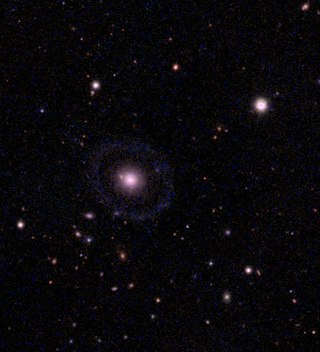Top Qs
Timeline
Chat
Perspective
LEDA 1000714
Hoag-type ring galaxy in the constellation Crater From Wikipedia, the free encyclopedia
Remove ads
LEDA 1000714[3] is a ring galaxy in the constellation Crater. LEDA 1000714 is one of a very rare group of galaxies called Hoag-type galaxies,[3] named after the prototype, Hoag's Object – it is estimated that roughly 0.1% of all galaxies are this type.[5][6]
LEDA 1000714 is unusual because it is a Hoag-type galaxy with two nearly round rings, but with different characteristics.[7] It has been nicknamed Burçin's Galaxy, after Burçin Mutlu-Pakdil,[3] the leader of the photometric study of this galaxy.
Remove ads
Structure
Summarize
Perspective
The structure and photometry of LEDA 1000714 was studied with significant detail in 2017. The core of the galaxy appears to be similar to an elliptical galaxy, and is almost perfectly round, not flattened into a disk. Unlike some ring galaxies, the central core shows no signs of a bar structure connecting the outer ring to the center of the galaxy. This is similar to Hoag's Object, and a number of other galaxies have been found that have a perfectly round center.[3]
The outer galaxy is relatively bright and contains many luminous stars indicative of star formation. However, upon further inspection of the galaxy, it was found that inside the outer ring there is also a faint, diffuse, red inner ring closer to the core. The outer ring appears to be fairly young, at about 0.13 billion years old, while the core is much older, at 5.5 billion years old. The age of the inner ring is, as yet, undetermined. This makes the galaxy even more unusual, possibly making it one of a kind.[3]
The details of the formation of Hoag-type objects are still largely unknown.[7] It has been suggested that the near-perfect core of Hoag's Object formed from a sort of "bar instability" where the central bar structure decays into a rounder core.[8] It may also be due to another galaxy. In the case of LEDA 1000714, because its two rings have significantly different ages, the galaxy's morphology may have come from an anomalous collision with another galaxy, however more data is needed to draw conclusions.[3]
Remove ads
References
Wikiwand - on
Seamless Wikipedia browsing. On steroids.
Remove ads

